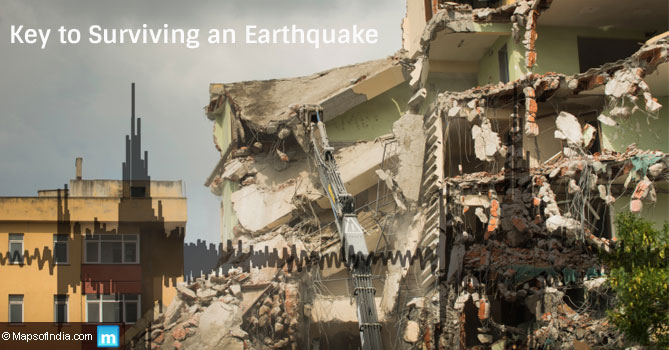An earthquake is one of the most dreadful and devastating natural calamity and has terrible after effects. Tectonic plates are always moving slowly, but due to friction, can get stuck at their edges. When the stress on the edge overcomes the friction, an earthquake occurs. The earthquake releases energy in waves, which travel through the earth’s crust and cause the ground to shake. The energy builds up in the same way such as that in the spring of a watch when it is wound. The waves can travel a very large distance. Just like ripples on a pond the seismic waves spread out from the preliminary point of cracks. The places near the epicenter are the most affected.
The Indian subcontinent has suffered many catastrophic earthquakes which have caused immense loss to life and property. In India, scientists have identified high-risk areas. The Meteorological Department has published an Indian map in collaboration with the Indian Standard Institution on the basis of severity and hostility of the earthquakes. This map indicates five seismic zones which are based on Mercalli Scale.
Zone I: This zone has been categorised as Intensity V or below which is weak and marginal. It includes some parts of Punjab, Haryana, Bihar, West Bengal, plains of Uttar Pradesh, main parts of Gujarat, except Kutch and coastal plains of Maharashtra and Kerala.
Zone II: It has been categorised as intensity VI and is strong. It covers Southern Punjab and Haryana, parts of plains of Uttar Pradesh, coastal areas of Tamil Nadu and Odisha and eastern Rajasthan.
Zone III: This intensity VII earthquake is very strong. It covers major parts of Madhya Pradesh, Karnataka, Jharkhand, Maharashtra, southern and southeastern parts of Rajasthan and northern and northwestern parts of Odisha.
Zone IV: This zone has been identified as destructive and is capable of causing high damage. It is categorised as intensity VIII and covers northern parts of Punjab and Haryana, Himachal Pradesh, Delhi, eastern Uttar Pradesh, Jammu and Kashmir, the Himalayan areas of Uttaranchal, Sikkim and Bihar and tarai and bhabar regions.
Zone V: This zone has been indicated as the most disastrous and catastrophic earthquake prone area with intensity of more than VIII. It comprises certain parts of Jammu and Kashmir, Himachal Pradesh, Monghyr and Darbhanga districts of Bihar, Uttaranchal, northern parts of India and Gujarat’s Kutch region.
As an earthquake can occur at any place and at any point of time, some necessary precautions have to be taken. During an earthquake, buildings and other structures tend to collapse causing huge damage to lives and property.
Some Precautions to be taken for New Buildings and Structures
- Buildings and structures should be constructed only after the soil testing is done.
- The quality of rods, sand and cement should be maintained. The rods should be used based on the foundation type and should be earthquake resistant.
- Professional engineers should be engaged and involved in designing the structures and buildings.
- The concerned authority should check the column and slab design requirements.
- Mandatory and required wall space should be allocated in case of multistory buildings.
- To impart extra earthquake resistance to the buildings and structures the tail of a bond in the column rod should be 135 degree and the distance between the bonds should be less.
- There should be absolutely no connection in the intersection of beam column.
- BIS codes should be followed which are appropriate for your area.
Precautions for Old Structures or Buildings
- To make old buildings and structures more resistant the columns should be made strong. Size of the column can be expanded from the foundation.
- To reinforce the walls, bracing can be utilized to make it earthquake resistant. If needed horizontal bracing can be added.
- If there is any indication of structural defects like cracks in foundations and ceilings than one should get advice from an expert.
- It is recommended that soil testing should be done again.
What should be done before an Earthquake?
- Overhead lighting fixtures should be fixed and fastened to the ceiling.
- Shelves should be fixed properly to walls. Large and heavy objects should be placed on the lower shelves. Glass items, bottled foods, which are breakable products, should be kept in closed and latched cabinets. Pesticides and inflammable products should be stored on bottom shelves of the latched cabinets.
- Defective electrical wiring and leaky gas connections should be repaired as they can trigger fire. LPG cylinders, water heaters etc. should be strapped properly to the wall or should be bolted on the floor.
- Safe places should be identified, both indoors, as well as outdoors where one can seek refuge in case an earthquake occurs. One should identify an open area which should be away from trees, buildings, electrical lines, bridges and flyovers.
- We should have the required information such as emergency telephone numbers of doctors, police, hospitals etc.
- Disaster emergency kit should always be ready such as battery operated torch and radio, first aid, candles and matches, essential medicines, some dry food items and water.
Necessary Actions to be taken during an Earthquake
- Lie on the ground, take shelter under a solid table or any other furniture and hold it very firmly till the earthquake is over. One should crouch in an inside corner of the building by covering face and head with one’s arms.
- Protect yourself by staying away from glass, windows and lighting fixtures and furniture which can fall.
- One should stay inside till the shaking stops and should use staircases instead of elevators.
- Power outages occur during an earthquake. In case of power outage, do not go outside till the shaking stops as it has been observed that people often meet with accidents when they try to move to different locations.
- If you are outdoor and in open space, you should not move but stay where you are. But if you are under any building, streetlights and utility wires, you should immediately move away from that place.
- If you are in a moving vehicle, then stop quickly in a safe open space and stay inside the vehicle. After the shaking stops you should go ahead with caution and should avoid bridges, roads or ramps which might have been ruined by the earthquake.
- One should not light a match stick if trapped under debris. The mouth should be covered with a handkerchief or cloth as one may inhale huge amount of dust. Tapping on a pipe or wall helps the rescuers to locate. Shouting should be the last option so that inhaling of risky dusts can be avoided.
Measures to be taken after an earthquake
- You should check yourself as well as others if there is any injury. In case of injuries first aid should be provided immediately.
- Radios should be turned on and usage of phones should be restricted and calls should only be made during any emergency.
- Electric lines, water and gas should be checked. Their valves should be closed if they are damaged. You should open the windows and doors if you smell gas and leave immediately.
- You should stay out of wrecked buildings and devastated areas. Sturdy shoes and boots should be put on and staying near debris should be avoided.
- After the ground stops shaking tsunamis can occur. So it is advised to avoid beaches after the earthquake.
- Follow the emergency plan and instructions if you are at school or work.
Related Information
Top 10 Earthquake-prone Cities in India
Areas Affected by Earthquake in North India and Nepal





